Displaced Communities
![]() BALTIC GERMANS (150,000
BALTIC GERMANS (150,000
displaced by Hitler & Stalin; 95%+)
![]() GERMANS OF YUGOSLAVIA
GERMANS OF YUGOSLAVIA
(over 200,000 expelled, imprisoned, displaced, emigrated; 98.5% total)
![]() VOLGA GERMANS (over 400,000 expelled by Soviets to Kazakhstan)
VOLGA GERMANS (over 400,000 expelled by Soviets to Kazakhstan)
![]() DUTCH GERMANS (3,691 expelled,
DUTCH GERMANS (3,691 expelled,
15% of German population)
![]() GERMANS OF ALSACE-LORRAINE
GERMANS OF ALSACE-LORRAINE
(100-200,000 expelled after WWI)
![]() GERMANS OF CZECHOSLOVAKIA
GERMANS OF CZECHOSLOVAKIA
(over 3,000,000 expelled
and displaced; 95% total)
![]() GERMANS OF HUNGARY
GERMANS OF HUNGARY
(over 100,000 expelled, over
300,000 displaced; 88% of total)
![]() GERMANS OF ROMANIA
GERMANS OF ROMANIA
(over 700,000 or 91.5% displaced by Hitler, USSR, & emigration)
![]() US Internment of German-Americans, Japanese, & Italians
US Internment of German-Americans, Japanese, & Italians
(10,906+ interned & blacklisted) NEW!
![]() GERMANS OF POLAND, PRUSSIA
GERMANS OF POLAND, PRUSSIA
(over 5,000,000 expelled and displaced, nearly 100%) COMING SOON
![]() GERMANS OF RUSSIA/UKRAINE
GERMANS OF RUSSIA/UKRAINE
(nearly 1,000,000 to Germany and Kazakhstan) COMING SOON
Other Information
![]() OUR YOUTUBE CHANNEL NEW!
OUR YOUTUBE CHANNEL NEW!
(documentaries, interviews, speeches)
![]() Follow us on FACEBOOK NEW!
Follow us on FACEBOOK NEW!
(for updates, events, announcements)
![]() "Reactions of the British Public and Press to the Expulsions" NEW!
"Reactions of the British Public and Press to the Expulsions" NEW!
![]() "British Humanitarian Responses - or lack thereof - to German Refugees" NEW!
"British Humanitarian Responses - or lack thereof - to German Refugees" NEW!
![]() "British Political Responses to the German Refugee Crisis during Occupation" NEW!
"British Political Responses to the German Refugee Crisis during Occupation" NEW!
![]() From Poland, to Czechoslovakia, to Occupied Germany: My Flight from the Red Army to the West
From Poland, to Czechoslovakia, to Occupied Germany: My Flight from the Red Army to the West
(memoir about wartime flight & Jewish, Polish, & German daily life near Auschwitz) NEW!
![]() Daily Diary of Forced Labor in the Mines of Soviet Ukraine NEW!
Daily Diary of Forced Labor in the Mines of Soviet Ukraine NEW!
![]() The problem of classifying German expellees as a 'genocide'
The problem of classifying German expellees as a 'genocide'
![]() Why the German, Czech, and Polish governments reject expellee commemoration
Why the German, Czech, and Polish governments reject expellee commemoration
![]() Distorted historical memory and ethnic nationalism as a cause for forgetting expellees
Distorted historical memory and ethnic nationalism as a cause for forgetting expellees
![]() Ethnic bias and nationalist revisionism among scholars as a cause for forgetting expellees
Ethnic bias and nationalist revisionism among scholars as a cause for forgetting expellees
![]() The History and Failure of Expellee Politics and Commemoration NEW!
The History and Failure of Expellee Politics and Commemoration NEW!
![]() Expellee scholarship on the occupations of Czechoslovakia and the Sudetenland, 1918-1945
Expellee scholarship on the occupations of Czechoslovakia and the Sudetenland, 1918-1945
![]() Sexual Violence and Gender in Expellee Scholarship and Narratives
Sexual Violence and Gender in Expellee Scholarship and Narratives
![]() Suggested Resources & Organisations
Suggested Resources & Organisations
![]() In Memoriam: Your Expellee
In Memoriam: Your Expellee
Relatives & Survivors
![]() Submit content and information
Submit content and information
![]() How to support German expellees / expellee political lobbies
How to support German expellees / expellee political lobbies
black tulip: expelling german 'hostile
citizens'
from the Netherlands
![]() Print this Article •
Font Size: -
+ •
Print this Article •
Font Size: -
+ •
![]() Send
this Article to a Friend
Send
this Article to a Friend
HOW TO CITE THIS SCHOLARLY ESSAY: Institute for Research of Expelled Germans. "Black Tulip: Expelling German 'Hostile Citizens' from the Netherlands." http://expelledgermans.org/dutchgermans.htm (accessed Day-Month-Year).
Total population change resulting from expulsion and displacement: 3,691 expelled, 15% of total German population
_______________________________________
![]() History of Settlement and the question of responsibility
during Dutch National Socialism
History of Settlement and the question of responsibility
during Dutch National Socialism
![]() History of Expulsion
History of Expulsion
![]() Sources/Bibliography
Sources/Bibliography
![]() Population
Statistics
Population
Statistics
![]() Suggested
Websites and Organisations
Suggested
Websites and Organisations
_______________________________________
History of Settlement, Culture, and the question of responsibility during Dutch National Socialism
It is difficult to isolate the historical process of ethnic German minourity settlement in the Netherlands because of the extremely close relationship between the Dutch people and the Germans in their shared history. In essence, the Flemings, Frisians, and Dutch (related to the word 'Deutsch') people altogether descend from German settlers in the Low Countries who spoke the Old Low German (Altplattdüütsch) and Old Low Franconian (Altniederfränkisch) dialects and were separated from Germany proper's political orbit under Burgundian, Austrian, and Spanish rule before forging the sovereign Dutch Republic in 1648 after the 80 Years' War against Spain. Following this independent political and cultural evolution, settlers from Germany can be identified as a separate minourity population, the Dutch Germans. The Low Countries experienced steady immigration from Germany proper in reaction to political, economic, and agricultural crisis. The 30 Years' War (1618-48) decimated German peasant communities, creating rampant famine and disease that crippled their agricultural capacity and stimulated widespread diasporic emigration, particularly to the Netherlands due to the close cultural and linguisitic affinities. So too, Lutheran and Calvinist peasants facing persecution in Catholic states of Germany flocked to the Protestant Netherlands for greater rights of worship and independent franchise. As it evolved throughout the 19th century to become an industrialised state with auspicious commercial opportunities for labourers and entrepreneurs, the Netherlands endured consistent (yet small-volume) immigration from Germany until World War II. Upon settlement, the German immigrant community retained the modern German language, their separate religious affiliations (especially Catholicism and Lutheranism instead of the dominant Calvinism), and have since functioned on statistics and in Dutch society as a separate ethnic community and identity affiliation within the general population.
The German-speaking minourity in the Netherlands remained integrated into the Dutch economy as labourers and business proprietors during both World Wars and in the inter-war period. During World War I, the Netherlands remained neutral, and was not invaded by the German Second Reich unlike its Belgian neighbours. Germany and the Netherlands had a rather amicable relationship that was even exploited by the deposed German emperor Wilhelm II, who was given asylum in the Netherlands after the war and remained protected there for the remainder of his life despite Allied admonitions. Many Germans continuously emigrated to the Netherlands to enjoy their greater economic and political stability and escape the revolution and collapse that swept the German Weimar Republic after 1918. Dutch coal mines and factories enjoyed heavy influxes of German minority workers after the French occupation of the Ruhr Valley by 1923, making up as much as 25% of the labour force in mining villages along the Dutch-German border, and therefore played an integral role in Dutch society and economics (Moore 1987).
This copasetic and cooperative association between the Dutch and the Dutch German minourity predictably changed into bitter discord with the coming of the era of National Socialism (Nazism) and Nazi Germany's military occupation. The Dutch historical memory and overall experience with National Socialism, the far-right interlude, and Nazi German rule was disastrous, complicated, and remains highly controversial. Although the small German minourity was universally proscribed after the war for perpetrating Nazi atrocities and collabouration with the invading German armies, and was targeted for complete expulsion, the Netherlands had its own powerful and independent Dutch analogue of racialist and pan-Germanic movements that mirrored their political ideology after Fascist models in Austria and Germany. The Dutch National Socialist Movement (nationaal-socialistische Beweging), led by Anton Mussert and Cornelis van Geelkerken, was one of many independent Dutch radical movements that participated in a precarious political struggle in the Netherlands between the fiercly independent centrist majourity and far-right and far-left fringe antagonists. Dutch nationalists were actively effusive with pan-Dutch, pan-Fleming, and pan-Germanic sentiment, drawing on a common genetic and cultural heritage from the Flemings, Frisians, and the Germans. Scholars and laymen within Dutch society today have great difficulty agreeing whether the war-time legacy of National Socialism, occupation, and the deportation and systematic murder of the Netherlands' large Jewish populations are to be attributed solely to the tiny German minourity, the Dutch themselves, or both.
What is certain, however, is that after the illegal conquest of the Netherlands the occupying German military regime enjoyed a large number of native Dutch volunteers and supporters who expedited the Nazi atrocities. This limited collabouration notwithstanding, the overwhelming majourity of Dutch people strongly opposed the illegal occupation of the Netherlands and sought to re-establish the sovereignty of their nation. What is also certain is that after the war, responsibility for the atrocities and anti-Jewish pogroms was almost entirely diverted onto the tiny German minourity (only 25,000 Dutch Germans out of 10,000,000 total population [Statistics Netherlands 2]), which was subsequently scapegoated, excluded, and proscribed as 'hostile' simply because of their spoken language and ethnic affiliation and targeted for mass expulsion regardless of their divers political ideologies or verifiable connections to the subversive far-right. The tiny German minourity was universally equated with an irredentist 'Fifth Column' with surruptitious designs to incorporate the otherwise-independent Netherlands into a greater German Reich. This presumption finds difficulty when the fact is considered that the Dutch Nazis sought to remain an independent Dutch nation and not be annexed into Germany (Burleigh 2001, 420), and instead promoted a pan-Germanic confederacy of sorts. Similar to the far-right Flemish and Walloon radicalism in neighbouring Belgium, Dutch Nazism was specifically non-German and independent in its political and ethnic nationalist aspirations, rather than being an infiltrative movement imported by the subversive German minourity.
In 1940, despite the Netherlands' firm desire to remain independent and neutral, the Third Reich initiated the so-called Fall Gelb ('exercise yellow'), and began a brutal Blitzkrieg bombing of Dutch cities and civilian populations without provocation. After the Netherlands was conquered in a matter of months, the influential, yet minourity far-right parties were placed in control of the government as puppet vassals. The Dutch Nazi Anton Mussert became the effective governor and 'Führer' of the Dutch people (according to Propaganda Minister Joseph Goebbels [Goebbels 1948, 234]), working with the Austrian Nazi leader Arthur Seyß-Inquart to create a Nazified, pan-Germanic Dutch society in service of the Third Reich. Local Dutch SS legions (particularly SS-Germania, SS-Nederlandsche, and SS-Landstorm Nederland) were staffed by thousands of Dutch and Belgian volunteers who tragically collabourated with the occupying German police to purge the entire Jewish population from the Netherlands, in addition to the far-left, anarchist, homosexual, disabled, and classified Antisocial elements. The Dutch German population mostly joined the native Dutch far-right movement, volunteered for the German army or the SS, or emigrated to Germany or abroad.

The standard of the independent Dutch Nazi Party since 1931,
based on a pan-Germanic Rune. The emphasis on a shared Germanic
heritage by Dutch and Dutch German Nazis implied (falsely)
that the ethnic Dutch Nazis were plotting to annex the Netherlands
into Germany (source: crwflags.com)
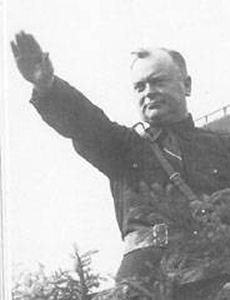
Anton Mussert, the 'Leider' of the Dutch Nazi Party (nationaal-socialistische
Beweging) (source: axishistory.com)
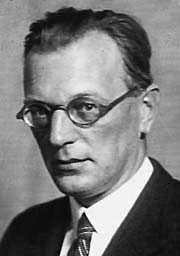
The Austrian Arthur Seyß-Inquart, the official de jure governor
of German-occupied Netherlands over Anton Mussert.
By the end of 1945, the Third Reich was defeated and the sovereignty of the Netherlands was re-established. The leading Dutch Nazis, understandably considered traitors and Quislingists for their collabouration with the occupying invaders, were shot or gaoled indefinitely. Most leading Dutch Nazis, including Anton Mussert, were executed by firing squad. As a result of the war and the occupation, anti-German sentiment in Dutch culture was rampant, and few were encouraged to express concern for possible human rights violations committed against ethnic German prisoners of war or even civilians who simply spoke the German language. The war-time atrocities, the illegal invasion of the Netherlands by Germany, and the denial of Dutch sovereignty were dismissed as being the work of the German minourity of only 25,000 despite the large number of Dutch participants in far-right Nazi movements and the fact that the small resident German population had equally diverse political ideologies as the Dutch. Although a sizable portion of the German minourity did support the incoming Germans, most were committed participants in Dutch society and likely viewed the invading German army as a belligerent oppressor for destroying their nation and/or for violating the rights of a fraternal Germanic culture. Dutch estimates for those suspected of collabouration ranged as high as 170,000 Dutch citizens (both of Dutch and German ethnicity) directly sponsoring or participating in the German occupation interlude (Andere Tijden), far more than the 25,000 Dutch German population (Statistics Netherlands 2). This implies that the Dutch government and society scapegoated their Dutch German population by diverting potentially embarrassing blame for Nazi atrocities entirely off of the Dutch and onto a bitterly-hated minourity. A foreign traveler in 1948 noted the longstanding firm hatred for Germany and the Germans as a result of the occupation, writing that, 'the Dutch do not even want to hear the word 'Germany', since the Germans had caused so much grief during the war' (Mazower 2000, 216). In fact, small segments from both the Dutch and Dutch German communities played varying degrees of responsibility, but it was the Dutch German civilians – 25,000 out of a nation of 10,000,000 in 1950 (Ibid.) – who were to feel the consequences after centuries of residence and separation from the Germany that they were universally accused of serving as surruptitious irredentist agents.
In 1937, there were 1,925 registered members of the German Nazi Party (NSDAP, or at least the SA or SS) living in the Netherlands, only 2.56% of the total Dutch Geman population in the Netherlands (Moore 1987). At the same time, there were over 48,000 members of Anton Mussert's native independent Dutch Nazi party alone (Zwaan, 1984), although scoring only roughly 4% of the elections in 1937 (Auschwitz.nl). This intimates that the excluded Dutch German minourity was inaccurately and universally proscribed for the legacy of Nazi occupation, asserting that the 25,000 Dutch Germans were a universally 'hostile citizen' population and that the Dutch had almost no involvement in the far-right collabouration movements. Admittedly, pan-Germanic, nationalist, and racialist thought was prolific in the Low Countries just as it was in Germany and Austria, and as in the Third Reich a huge number of Germans and Dutchmen had pan-Germanist and far-right personal ideologies without officially joining any marginal political party. This renders statistical proof of the degree of personal involvement with the Nazi occupying army difficult to ascertain. Nonetheless, the Dutch German 'Fifth Column' of irredentists was to be universally excluded from Dutch society as war criminals.
By the end of 1945, the restored Dutch government initiated Operation Black Tulip (zwarte tulp, although this is a term invented by the British), a scapegoating campaign to expel the entire ethnic German civilian minourity from the Netherlands. This policy disregarded these civilians' divers political beliefs and lifestyles, and included both accused far-right Fascists, pan-Germanist irredentists, and liberal democrats. So too, it targeted not only German-speaking citizens who had settled during German occupation from 1940-45, but also those German-speaking civilian families who had lived in the Netherlands for centuries long before any German invasion or any Nazi atrocities. It was not a programme targeting German prisoners of war or war criminals who were directly verified of collabouration with the Nazis, but against everyone who spoke the German language and recording German ethnic affiliation on population statistics. The German civilians were subjected to discriminatory and exclusionary status as 'hostile citizens' (vijandelijke burgers). Understadably widespread Germanophobia furthered their exclusion from Dutch society because of Hitler's invasion, and discouraged any widespread public backlash from general Dutch society for their well-being.
The removal of the Dutch German ethnicity was also planned in a convenient geopolitical and quasi-nationalistic context. German civilians were to be expelled in the interests of Dutch post-war expansion opportunities. As Germany ceded its periphery territories that were subsequently given to Poland (Prussia), the Czech Republic (Sudetenland), and France (Alsace-Lorraine). the Dutch understandably hoped to annex parts of Germany near their shared border. Under the Bakker-Schut Plan, the Netherlands proposed an enlargement of its national boundaries by almost 40% as an indemnity for the horrendous suffering inflicted on the Dutch people during and after Germany's invasion. At the same time, a financial indemnity of 25,000,000,000 Dutch guilders was demanded from Germany, which eventually was revoked due to West Germany's bankruptcy (Canaday 2009). Many pundits argued that the border area between Germany and the Netherlands long shared commercial and cultural ties to the Dutch people (especially the border-straddling Friesland region), and should thus be incorporated into the Kingdom of the Netherlands. The collateral victims of this expansionist plan were to be the German civilians in both British-occupied Germany and the Netherlands itself. Theoretically, the Bakker-Schut Plan called for an additional expulsion of Germans in the new areas annexed from Germany, planned to be repopulated by Dutch citizens in a massive population exchange. The annexed eastern marches that reached even as far east as two of Europe's and Germany's oldest cultural cities of Aachen and Köln (Cologne), were referred to as 'Our Land' by Dutch nationalists in the government under the slogan 'let the Dutch border reach the Weser' (Strange Maps).
Ultimately, the understandable Dutch plans for expansion and restitution for Germany's war-time atrocities failed miserably. Northwest Germany, which the Netherlands claimed, was occupied by the British, who were unwilling to deal with the intense political and inter-ethnic crisis of population exchange across the Dutch-German border. Occupied Germany was also being flooded by immigration of over 10,000,000 German civilians expelled from their homes in Hungary, Czechoslovakia, Poland, Yugoslavia, and Romania. As a result, the Dutch expansion plan was rejected by the British and only earned the Netherlands a few peripheral border towns. Most of these few cities and islets were later purchased by West Germany to the point that the Netherlands eventually only gained the small area around Duivelsberg, only some 125 hectares (Strange Maps). As a result of this failed expansion plan, the Netherlands did not get a chance to expel or exchange the large German majourities in the regions of Niedersachsen and the Rheinland (northwest Germany) claimed for annexation.
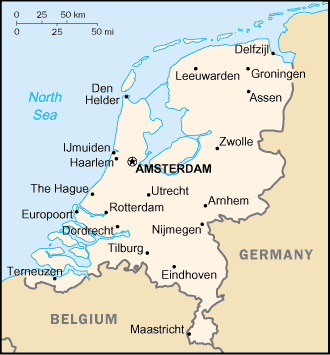
A
map of the Dutch-German border. The Dutch government planned
ideally to expand 30% or more into German land as indemnity
for the illegal invasion of the Netherlands by the Third Reich
(source: CIA World Factbook)
The effect that the campaign would eventually have had on the German majourity in the German territories planned for annexation was not fully defined. The British intervention theoretically may have saved the expulsion and forced relocation of tens or even hundreds of thousands of German civilians if the Netherlands had the chance to initiate population exchange in newly-annexed territories that had large German majorities. Ironically, the British even responded to Operation Black Tulip by expelling over 100,000 Dutch citizens from the British occupied zone, including many working for post-war subsidised reconstruction projects in Germany (Crossroads).
Operation Black Tulip targeted all of the Netherlands' 25,000 Dutch Germans (Andere Tijden). The immediate target would be families who had settled after 1940, meaning during occupation. In most cases, displaced families were given no more than an hour to gather all of the valuables they could carry into basins or personal baggage totaling no more than 50 kg to take with them (Crossroads). Their homes, property, and private businesses were confiscated and annexed to the state (Andere Tijden). The civilians were then arrested and taken by the military to temporary refugee or prison camps near the border, especially the prison camp of Marienbosch. After brief imprisonment and circulation, these German civilian political prisoners were expelled to the British occupied zone of Germany or to Belgium, or into general diaspora. In total, some 3,691 civilians were expelled simply because of their language and ethnic identity (Andere Tijden).
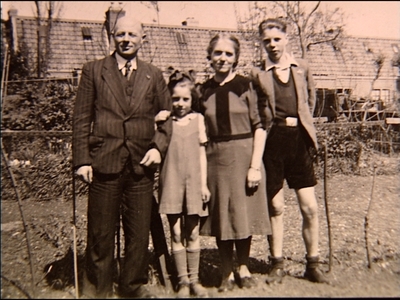
A Dutch German family threatened by expulsion
under Black Tulip (source: Andere Tijden)
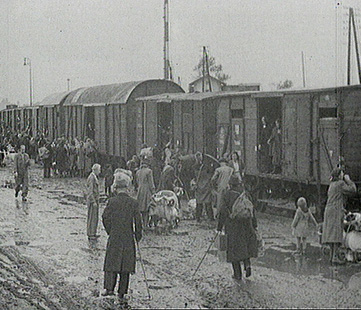
German civilians boarded onto trains for compulsory expulsion,
their property forfeited (source: Andere Tijden)
Operation Black Tulip was officially ended prematurely by 1948 after less than 3 years of activity for a number of reasons: 1) expelling a minourity population that was integral to the Dutch economy during a time of post-war economic collapse was detrimental, since there were now over 57,375 other German immigrant wage-earners in 1930 (Moore 1987); 2) the Dutch Germans were deemed to be 'pacified' from their status of 'hostility' after the anti-German hysteria of 1945 gradually cooled down; 3) relations between the Netherlands and the nascent West Germany had normalized, and; 4) especially because the Dutch plans for nationalistic expansion and resettlement of Germans on the expanded Dutch-German border had been demolished by the British intervention. The actual forced expulsion undertaken by the Netherlands was comparatively mild and clement in comparison with those performed by the governments of Poland, Czechoslovakia, and the USSR. It was the only plan for universal expulsion of German civilians after World War II that did not completely vanquish the entire settled community. Only less than 15% of the total Dutch German minourity population in the demarcated Netherlands were expelled. There were no reports of forced labour or rape and murder of Dutch German prisoners in Dutch concentration camps under Operation Black Tulip, unlike in the Czechoslovak, Polish, Yugoslav, and Soviet expulsions of their German civilian populations. It was even possible in some cases to avoid expulsion in the case of families that had famously assisted the Dutch resistance. So too, those Germans who spoke Plattdüütsch (the Low German dialect, very similar to Dutch) were, at least superficially, told that they would not be expelled so long as they had no family in Germany, no far-right or pan-Germanic affiliations, and promised to assimilate and abandon German identity for Dutch nationality. As of 2009, there are still 379,559 Germans in the Netherlands (Statistics Netherlands 1).
Despite the fact that the actual campaign enacted by the Dutch government in Operation Black Tulip was ultimately benign in comparison with the debatable genocide committed by the USSR and other nations, this is arguably only because of the British intervention into Dutch expansionism. If the Dutch had annexed border cities and territories with overwhelmingly German populations like Köln and Aachen, the government would have initiated a full-scale population resettlement and expulsion as stipulated under the Bakker-Schut Plan. The Dutch government intended to completely expel all significant German settlements in the newly-annexed territories along with the Dutch Germans in the Netherlands. The resulting inter-ethnic strife and violence caused by the massive expulsions would likely have required far more intensive expulsion efforts by the Dutch government, leading to far more bloodshed than ultimately occurred. Although finally the experience of the Dutch Germans after the war only forced some 15% out of their homes, it must be remembered that Operation Black Tulip originally planned to discriminate against and expel all Dutch German civilians with an ethnicity-based removal. Arguably, the fate of many more than 15% of the Germans was saved at the last minute by a British geopolitical intervention against Dutch expansionism. Regardless of the fact that only less than 5,000 Germans were expelled, Operation Black Tulip was one of many programmes across the continent seeking to evict all persons of German ethnicity and language from their homes because of generalised and unverified stereotypes that all Germans were an inherently volatile source of far-right Nazism and pro-German war collabouration. The small Dutch German minourity, an integral part of the Netherlands for centuries, was an easy scapegoat for the Dutch government to burden with a legacy of mass genocide, the Holocaust, and collabouration with occupying belligerents despite the Dutch Germans' eclectic political beliefs and the significant number of Dutch supporters of National Socialism both before and during German occupation.
Concluding note courtesy our affiliated researcher Angela Boone of Operatie Black Tulip (operatieblacktulip.nl):
With regards to the number of deported Germans from the Netherlands, [it is true that] the number of 3.691 is an underestimation. This 'official' figure is false and is certainly not based on deportation lists. Many deportation lists are lacking ... which makes it completely impossible to mention the exact number of deported Germans from the Netherlands. As well it is impossible to state which percentage of Germans was deported after the war. German Jewish Holocaust survivors (an unknown amount) were deported from the Netherlands as well. During tracing research conducted by the Red Cross no distinction was made between German Jews deported during and after the war from the Netherlands. An exceptional high amount of German Jews was deported from the Netherlands during the war, according to the 'official' figure a very low number of Germans was deported from the Netherlands after the war. Operation Black Tulip might provide an explanation for the significant differences between the Netherlands and other countries.
Andere Tijden - Geschiedenis. "Black Tulip." Andere Tijden. http://geschiedenis.vpro.nl/afleveringen/23997653/.
Burleigh, Michael. The Third Reich: A New History. Hill and Wang, 2001.
Canaday, Marquis."Germans kicked out of the Netherlands." Associated Content, 12 March, 2009.
Crossroads Magazine. "How the tulip came to Holland." http://crossroadsmag.eu/2006/03/how-the-tulip-came-to-holland/.
Goebbels, Joseph. The Goebbels Diaries. Trans. by Lochner. Garden City, NY: Country Life Press, 1948.
Mazower, Mark. Dark Continent: Europe's Twentieth Century. New York: Vintage Books, 2000.
Moore, Bob. " Nazism and German Nationals in the Netherlands, 1933-40." Journal of Contemporary History Vol. 22, No. 1 (January, 1987): 45-70.
Statistics
Netherlands. "Population; generation, sex, age and origin"
(2009). Centraal Bureau voor de Statistiek. http://statline.cbs.nl/StatWeb/publication/?DM=SLEN&PA=37325eng&D1=0&D2=0&D3=0&D4=0&D5=
a&D6=12-13&LA=EN&HDR=G2,G3,G4,T&STB=G1,G5&VW=T.
Statistics
Netherlands. "Population; generation, sex, age and origin"
(1900-2000). Centraal Bureau voor de Statistiek. http://statline.cbs.nl/StatWeb/publication/?DM=SLEN&PA=37556ENG&D1=0-44,53-60&D2=1,11,21,31,41,51,
61,71,81,91,101&LA=EN&VW=T.
Strange Maps. "'Eastland, our Land' - Dutch dreams of expansion at Germany's expense." Wordpress. http://strangemaps.wordpress.com/2007/01/18/65-Bakker-Schut-a-plan-for-dutch-enlargement-at-germanys-expense.
Zwaan, J. De zwarte Kameraden. Amsterdam: Van Holkema & Warendorf, 1984.
Auschwitz.nl. "Nationaal-Socialistische Beweging." http://www.auschwitz.nl/woordenlijst/nationaal-socialistische-beweging.
Further reference: Steinweis, Alan E. The Impact of Nazism: New Perspectives on the Third Reich and its Legacy. Lincoln: University of Nebraska Press, 2003.
1900- approximately 31,900 Dutch Germans in the Netherlands
1910- 37,500
1960- 25,400
1970- 31,300
1980- 42,700
1990- 41,800
2008- 379,610
2009- 379,559
Suggested Websites and Organisations
The documentary 'Black Tulip' on the Dutch TV show 'Andere Tijden.' Click here for the video (in Dutch).
"Nationaal-socialistische Beweging," from Auschwitz.nl (link here)
